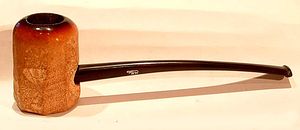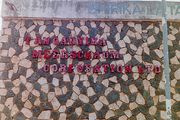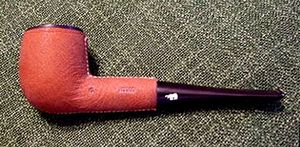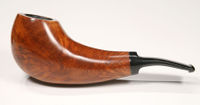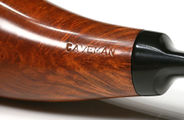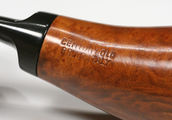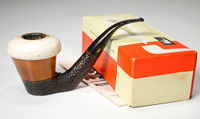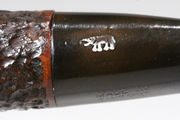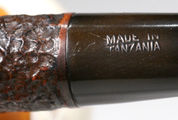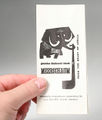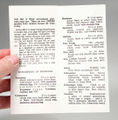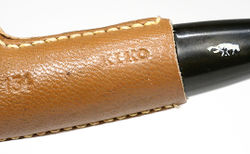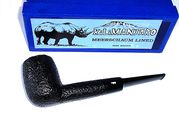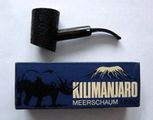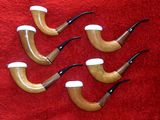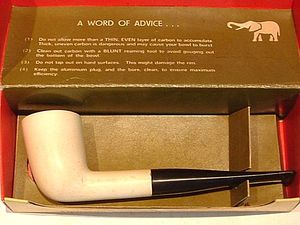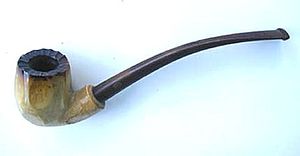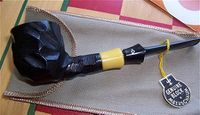Kiko
Kiko, meaning "pipe" in Swahili-Kiswahili to English translation, is probably the best known of the various brands listed below. In East Africa Meerschaum is found in Tanganyika, once known as German East Africa, and since 1964 part of the United Republic of Tanzania. The main deposit comes from the Amboseli basin surrounding the Lake Amboseli. Tanganyika Meerschaum is normally stained in shades of brown, black and yellow, and is considered to be inferior to Meerschaum from Turkey. Eventhough, the raw material is mined by the Tanganyika Meerschaum Corporation and to a large extent used for pipemaking. Uncounted pipemakers throughout the world were supplied with Amboseli Meerschaum, preferentially used for Meerschaum lined briars or leather-clad pipes. In Tanganyika the Kilimanjaro Pipe Company Ltd. produced (afak):
- Caveman Fashioned from a piece of natural meerschaum.Every pipe is unique and - is in fact a geological specimen over a million years old.Attractively boxed.
- Countryman(Elephant logo ) Block meerschaum with rustic finish either yellow or black.Individually boxed with protective chamois bag.
- Huntsman Block meerschaum black or yellow rustic bowl.Bamboo and vulcanite stem.Individually boxed with chamois bag.
- Hillibilly Block meerschaum,black or yellow corncob style finish.
- Kiko Rough (Elephant logo) Old seasoned briar.Block meerschaum lined with black rustic finish.Individually boxed.
- Kiko plain(Elephant logo) As for Kiko Rough but with smooth plum colour finish.
- Kikob (Elephant logo) Hillibilly style Briar block meerschaum lined.
- Kilimanjaro (Rhinoceros logo) East African pipewood Meerschaum lined and individually boxed.AvaiLable in black rough finish and natural smooth or rough finish.
- Kilimanjaro Giant (Rhinoceros logo) Finish as for standart Kilimanjaro,but available in three shapes only.Bent,Billiard and Oval Pot.
- Kudu (Giraffe Logo)
- Makonde (Rhinoceros logo)
- Merlin (Flying bird or Antelope logo)
- Sportsman (Logos Elephant) Block meerschaum,covered with hand-sewn English pig-skin.Individually boxed.
- Tembo
- Townsman Block meerschaum chaum with plain glossy yellow finish.Individually boxed with protective chamois bag.The Townsman is also available in the new styles.Townsman Crater,Townsman Scallope and NSC.
- Twiga (Giraffe Logo )
- White elephant (Logos Elephant)
- Caveman examples and details, courtesy Doug Valitchka
- Countryman example and details, courtesy Doug Valitchka
- Kiko Meerschaum flyer, courtesy Doug Valitchka
- Kiko Leather, courtesy Doug Valitchka
- More examples
Kilimanjaro is an old brand from Amboseli Pipes, that belonged to Tanganyika Meerschaum Corporation, created in 1955, in Nairobi (Kenia). This enterprise was founded after the discovery in the Kilimanjaro mountains of a big meerschaum mine. This meerschaum is not so good as Turkish one, because it is more compacted and do not less so well leaving out from the pipe the tar and nicotine. Soon after it was discovered another mine in the famous Amboseli Game Park. The enterprise had moved his headquarters to Arusha (Tanzania) and made an association with a Belgian company, but closed some years after. Some of the brands produced used pressed or compacted meerschaum and not block meerschaum.
The company had also an agreement with GBD,to make some lines of GBD Block Meerschaums. According to catalog 1976:
- Iringa - Leather covered, classic shapes.
- Jenga - "Rustic" peeble finish in a yellow tone.
- Kibo - High gloss finish in a yellow tone.
- Makonde
- Nusi - Black color, hand carved gouge finish.
- Tanzania - ???
After closing, the British companies London Meerschaum and Laxey Pipes Ltd. (from the town of Laxey, Isle of Man, UK - Brands: Man Pipes, Manxpipe, Manxman, Manxland e.c.) continued to produce pipes using imported meerschaum from Africa. Laxey Pipes Ltd. also prepared the meerschaum bowls from the late 1960's - 2001 Peterson, Barling, Comoy's, Noerding and others. Often, just the stems were different, while bowls were the same.
___
Important background informations:
Although Tanganyika still exists within Tanzania, the name is no longer used formally for the territory and its use can be politically sensitive, not only as throwback to colonial times, but also if it implies opposition to the union with Zanzibar. These days the name Tanganyika is used almost exclusively to mean the lake.
Lake Amboseli The salted lake of Amboseli, most of the time dry, is a large area of dusty desert. Once you crossed this arid dry-lake bed, beautiful green swamps, hidden nature's treasures irrigated by ground water coming from the largest single mountain of the world, Mt Kilimanjaro, offer an amazing ecosystem, a reminder of paradise and freshness. The main attraction is the view of elephants grazing in front of the majestic mountain - only visible early in the morning or late afternoon. This flat and dry area was 10,000 years ago a large and permanent lake over 40 meters deep. Since, the whole lake dried up and is today a small seasonal lake existing only after heavy and prolonged rains. Most of the dry-lake bed is covered by alkaline white ashes, remains of the eruption of the Kili a few thousands of years ago. Ashes are responsible of the constant dust in the park, the growing salinity of the soil and the destruction of woodlands! Swamps are oasis in a arid and dry surroundings and are the finest areas of the park, as they offer a wide variety of habitats for mammals and birds and many fresh grasses and aquatic plants. The presence of swamps is due to the streams running down from the Mt Kilimanjaro towards Amboseli plains. All streams are underground; there are no permanent rivers around the park.
The majestic Mt. Kilimanjaro (5,985 m - 17,685 ft), the greatest single moutain of the world standing amidst large herds of elephants wandering in the swamps.
History The Olduvai Gorge in northern Tanzania has yielded some of the earliest known hominid remains, dating from some 2 million years ago. Bantu-speaking peoples from western Africa migrated into the Tanganyika area (the mainland part of what is now Tanzania) in the earlier part of the 1st millennium AD, bringing with them iron working technology. There were trading contacts between the coast and Arabia (and possibly even India) from the beginning of the millennium, and there were Arab settlements along the coast throughout medieval times, introducing Islam. From around the 16th century Arab domination of the coast was challenged by the Portuguese. Zanzibar emerged as an important port in the 18th century and Arab traders penetrated the interior in search of slaves and ivory. In the early 19th century, they opened up the great slave route from Bangamoyo on the Indian Ocean to Ujiji on Lake Tanganyika. The British explorer Richard Burton first entered the territory in 1856, and was soon followed by John Speke, David Livingstone, and Henry Morton Stanley. In 1873, the British fleet forced the Zanzibar sultan to declare an end to the slave trade, although a reduced illegal slave trade continued. German colonization Tanganyika was visited in 1884 by the German Karl Peters, who concluded several treaties with the local chiefs. This enabled establishment of a German protectorate, as agreed at the Berlin Conference of 1885 when East Africa was partitioned between Germany and Britain (which held Kenya). German Christian missionaries entered the area, attempts were made to destroy local tribal structures and traditions, and there was forced labour for cotton plantations. This provoked African revolts in 1889, 1902, and 1905. The last, known as the Maji Maji rebellion, was crushed with great cruelty, and African casualties were enormous. During World War I, British and South African forces attempted to take the colony, but the Germans were not finally defeated until November 1918 (in the East Africa Campaign), after great loss of life. In 1920 the League of Nations awarded to Britain a mandate to govern virtually the whole of German Tanganyika. The mandate was turned into a United Nations (UN) trusteeship in 1946.
German colonization Tanganyika was visited in 1884 by the German Karl Peters, who concluded several treaties with the local chiefs. This enabled establishment of a German protectorate, as agreed at the Berlin Conference of 1885 when East Africa was partitioned between Germany and Britain (which held Kenya). German Christian missionaries entered the area, attempts were made to destroy local tribal structures and traditions, and there was forced labour for cotton plantations. This provoked African revolts in 1889, 1902, and 1905. The last, known as the Maji Maji rebellion, was crushed with great cruelty, and African casualties were enormous. During World War I, British and South African forces attempted to take the colony, but the Germans were not finally defeated until November 1918 (in the East Africa Campaign), after great loss of life. In 1920 the League of Nations awarded to Britain a mandate to govern virtually the whole of German Tanganyika. The mandate was turned into a United Nations (UN) trusteeship in 1946.
British rule in Tanganyika Under the terms of the League of Nations mandate, Britain was obliged to develop the political life of the territory. The British established many Africans in the lower ranks of the administration. This led to the emergence - earlier than elsewhere in eastern Africa - of a politicized class of Africans, who formed the Tanganyika African Association (TAA). To counter this tendency, the British unsuccessfully attempted to introduce indirect rule through traditional chiefs. In 1926, a legislative council was established to advise the governor, and spending on hospitals and disease eradication increased. However, African nationalist aspirations continued to develop. Concerns over the economic situation of African peasant farmers, and resentment of the privileges enjoyed by white settlers (a small minority of the population), encouraged the formation of the Tanganyikan African National Union (TANU) in 1954, under the leadership of Julius Nyerere.
Independence Tanganyika achieved autonomy in September 1960 and became a fully independent state within the Commonwealth in December 1961, with Nyerere as premier. In December 1962, when Tanganyika became a republic, he became the nation's first president. There were communist-inspired army mutinies in January 1964 but these were quelled with British assistance. In April 1964 Zanzibar united with Tanganyika, and in October 1964 the composite state changed its name to the United Republic of Tanzania.
Zanzibar to 1964 - The island of Zanzibar was settled by Arab traders in the 7th century, and under Portuguese control during the 16th and 17th centuries, whereupon it became a sultanate. In 1822 it was united with the nearby island of Pemba. It was a British protectorate from 1890 to 1963, when it became an independent sultanate again. A left-wing revolution followed, and the sultan was overthrown in 1964, paving the way for union with mainland Tanganyika. Zanzibar continued for many years to follow its own policies, including close relations with the communist countries of the Soviet bloc.
